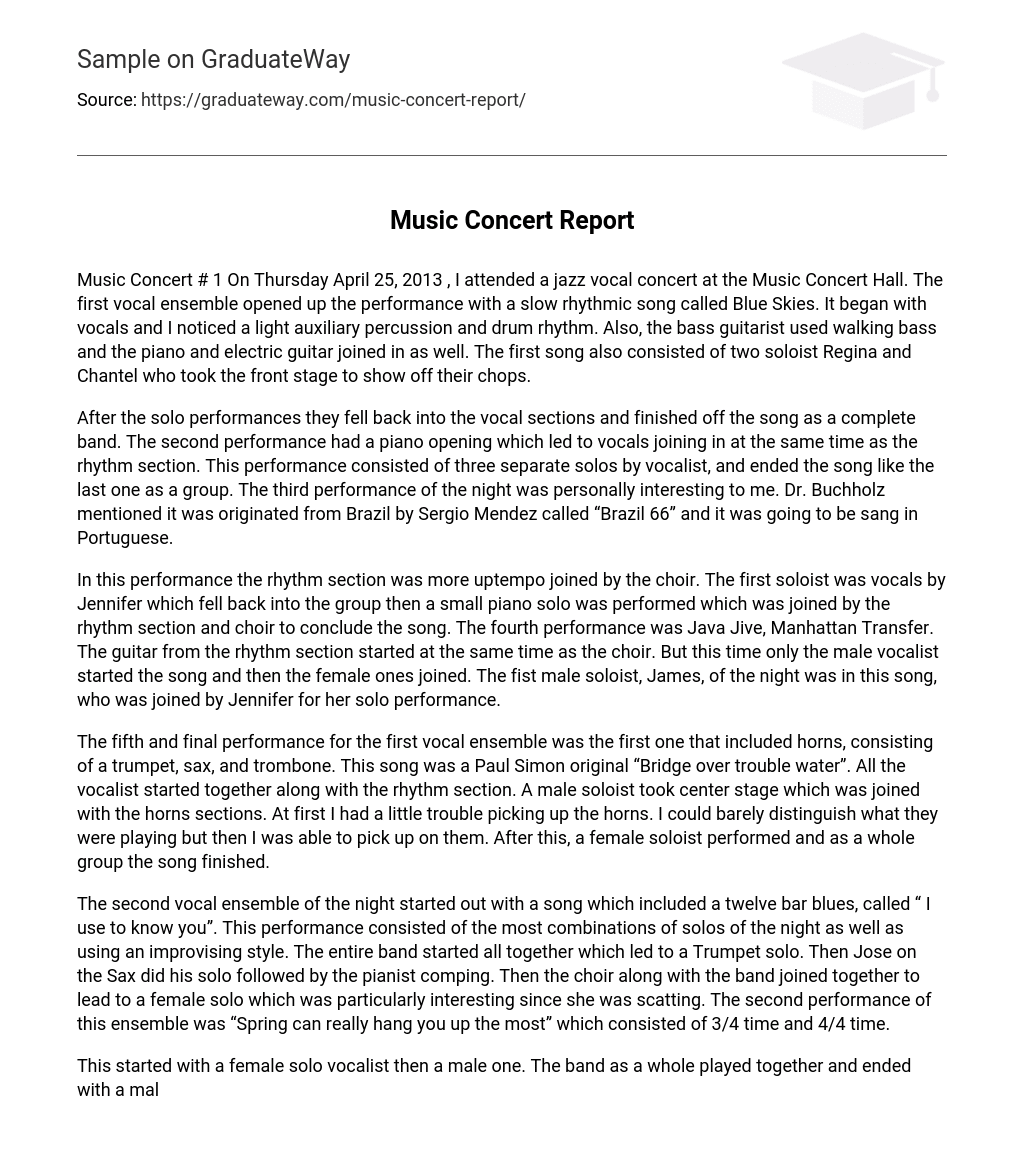On Thursday April 25, 2013, I went to the Music Concert Hall for a jazz vocal concert. The performance started with a slow rhythmic song called Blue Skies by the first vocal ensemble. The vocals were accompanied by light auxiliary percussion and drums. The bass guitarist played a walking bass while the piano and electric guitar also joined in. During this song, two soloists named Regina and Chantel took turns showcasing their skills on the front stage.
After their solo performances, the band regrouped for the vocal sections and concluded the song together. The next performance began with a piano introduction, followed by the rhythm section and vocals joining in simultaneously. This particular performance featured three individual solos by the vocalist and ended in a similar manner as the previous one, as a cohesive group. The third and most intriguing performance of the evening was introduced by Dr. Buchholz, who mentioned its Brazilian origin by Sergio Mendez, titled “Brazil 66,” and it was to be sung in Portuguese.
In this performance, the rhythm section played at a faster tempo and were accompanied by the choir. Jennifer was the first soloist, singing vocals before returning to join the group. Following that, a brief piano solo was performed, which was then joined by the rhythm section and choir to finish the song. The fourth performance featured “Java Jive” by Manhattan Transfer. The guitar from the rhythm section and the choir began simultaneously. Unlike earlier, only the male vocalist started the song, with the female vocalists joining in later. James, the first male soloist of the night, performed in this song and was joined by Jennifer for her solo performance.
The first vocal ensemble’s fifth performance featured the addition of horns to their song lineup. The horn section consisted of a trumpet, saxophone, and trombone. The chosen song was “Bridge Over Troubled Water,” an original by Paul Simon. The vocalists and rhythm section started the performance together, with a male soloist taking center stage. The horns joined in shortly after, though initially their sound was difficult to discern. However, I was eventually able to pick up on their contribution to the performance. Following the male soloist, a female soloist took over and the entire group finished the song together.
The second vocal ensemble of the evening began with a song called “I use to know you”, which featured a twelve bar blues. This performance showcased the highest number of solos throughout the night and incorporated improvisation. The entire band started playing together, followed by a solo on the trumpet. After that, Jose on the saxophone had his turn for a solo, accompanied by the pianist comping. Then, the choir and the band joined together to introduce a female solo, which was particularly intriguing as she engaged in scatting. The ensemble’s second performance was “Spring can really hang you up the most”, a piece that alternated between 3/4 time and 4/4 time.
This began with a female solo singer, followed by a male vocalist. The entire band performed together and concluded with a male solo scatting. The third performance of the night was a brief and delightful vocal acapella piece titled “Love walked in”. The fourth performance was a Richmond Rogers composition, featuring a rhythmic swing/salsa vibe reminiscent of “Lady is a tramp”. It commenced with the rhythm section, accompanied by the male vocalist and horns. Then, the female vocalist from the choir joined in and concluded this piece. The fifth performance by the group was a sequel to “Voice Stand”, an acapella piece by Greg Jaspers.
This song began with the choir utilizing their voices as instruments together. The ultimate performance of the evening featured New York Voices performing “Smack dab in the middle”, inspired by Count Basie and Joe Williams from the big band era. This composition truly demonstrated the musicians’ skill. Even though the horn and rhythm sections had only received this piece a week ago, they performed it exceptionally well. The piece commenced with the rhythm section followed by the vocals and horns simultaneously joining in.
I observed the trumpet player employing a mute just prior to a multitude of soloists displaying their musical prowess. Following numerous vocal solos, a sax solo ensued, causing the entire band to cease playing with the exception of the horn sections. Ultimately, the entire band rejoined to conclude this composition. In general, both ensembles delivered commendable performances, although the second ensemble’s greater experience resulted in my slightly greater enjoyment of their pieces. Each solo showcased the individual talent present within these groups, ultimately contributing to their overall status as a stellar ensemble.





